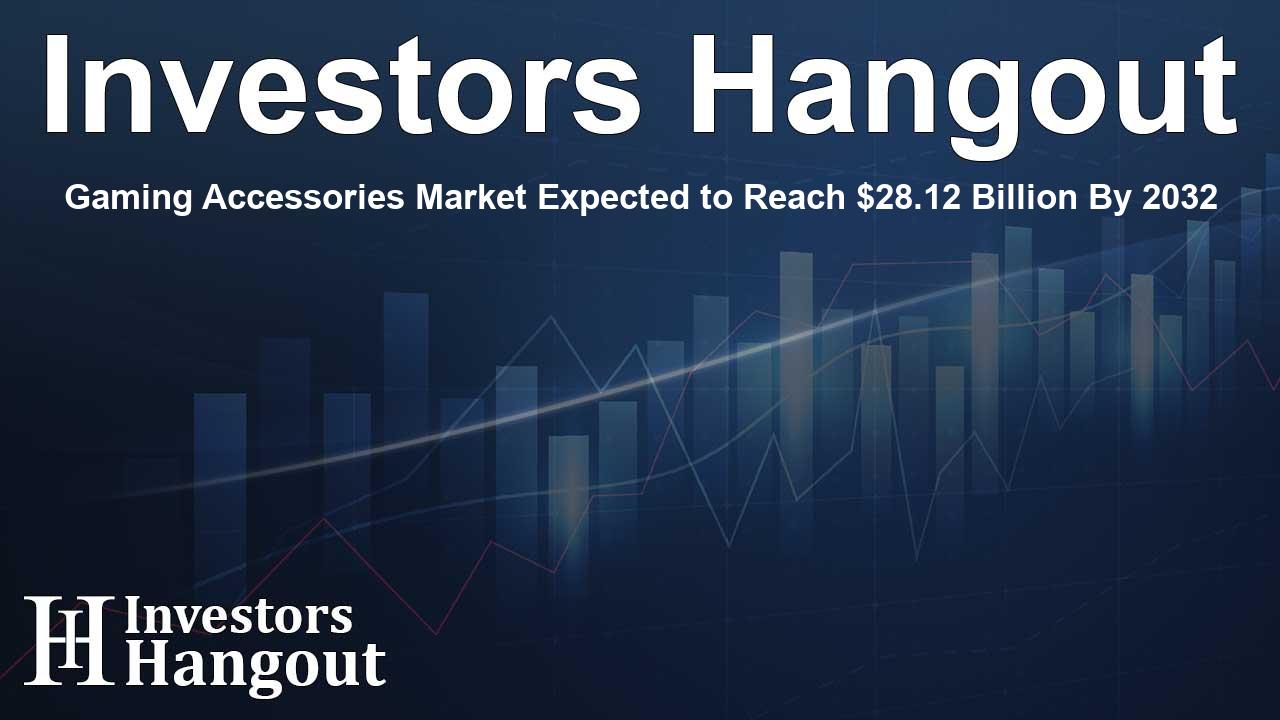Gaming Accessories Market Expected to Reach $28.12 Billion By 2032

Gaming Accessories Market: Overview and Growth Insights
The gaming accessories market is currently witnessing substantial growth, largely driven by the increasing adoption of innovative technologies such as virtual reality (VR) and augmented reality (AR). With a market size anticipated to reach USD 28.12 billion in the coming years, the anticipated compound annual growth rate (CAGR) stands at an impressive 9.94% from 2025 to 2032.
Transforming Gaming Experiences Through VR and AR
The dynamism in gaming experiences today is significantly shaped by VR and AR technologies. Enthusiasts are increasingly drawn to advanced gaming peripherals like VR headsets, motion sensors, and controllers that not only enhance gameplay but also transform the virtual interactions players can experience. Companies are innovating continually, with brands such as HTC Vive and Oculus pushing the envelope further in immersive gameplay.
Expansion of Product Offerings
This surge in interest sparks creativity among manufacturers, expanding their product lines to include next-generation accessories tailored for metaverse platforms and AR-centric games. As more gamers engage deeply with such technologies, the demand for sophisticated gaming environment accessories is generating a broader ecosystem in the gaming world.
Key Segments in the Gaming Accessories Market
Understanding the segments that drive this market is crucial. Different usage types—ranging from casual gaming to professional e-sports—affect the market landscape significantly. For example, the casual gaming segment accounted for approximately 40.10% of revenues recently due to a large demographic of casual gamers who favor mid-range equipment. Meanwhile, the professional gaming segment is experiencing rapid growth, indicating a CAGR of 10.29% during the forecast period.
User Insights and Preferences
The user preferences are shifting dramatically towards high-performance accessories. The expansion into e-sports competitions and player-sponsored leagues is pushing gamers to seek out durable, customizable peripherals that cater to their specific gaming style and needs.
Distribution Channels and Market Dynamics
The distribution dynamics also reveal valuable insights. Presently, offline retail holds a significant revenue share of around 45.10%, as players appreciate the opportunity to evaluate products physically before making a purchase. However, the online retail channel is making rapid headway, growing at a projected CAGR of approximately 10.55%. This growth can be attributed to the convenience of shopping from home, competitive pricing, and enhanced trust in online shopping experiences.
Regional Perspectives of Market Growth
Geographically, regions like Asia Pacific are expected to lead in growth with a CAGR of 10.87%. This is largely due to the expanding demographic of gamers, boosted by increased smartphone penetration and higher disposable incomes. North America remains a powerhouse in this sector, boasting a commanding revenue share of about 52.30% due to its established gaming infrastructure and numerous e-sports events.
Recent Innovations Shaping the Industry
Recent product launches reflect the vigorous innovation at play in this sector. For instance, Logitech introduced its new Powerplay 2 wireless charging mouse pad, designed to streamline player experience with a sleeker form and easy charging capability. Razer is also making waves with its new Basilisk Mobile mouse, catering to portable gamers who require lightweight devices without compromising performance.
Adapting to Consumer Trends
Beyond new product development, trends such as gamer behavior and usage show shifting patterns. Insights on device ownership, spending habits, and the balance between casual and professional gaming are essential for understanding future market directions.
Conclusion: The Future of Gaming Accessories
The gaming accessories market is on an exciting trajectory. With ongoing advancements and the expansion into immersive technologies, this sector is set to flourish. As companies adapt to evolving consumer preferences and technological developments, the landscape of gaming accessories will continue to transform.
Frequently Asked Questions
What drives the growth of the gaming accessories market?
The growth is driven by increasing demand for VR and AR technologies, along with a significant rise in professional and casual gaming.
How does the market size project from 2025 to 2032?
The market size is expected to rise from USD 13.23 billion to USD 28.12 billion during this period.
What are the leading distribution channels?
Currently, offline retail holds the largest share, but online retail is rapidly growing due to its convenience.
Which demographic contributes the most to gaming accessory sales?
Both casual gamers and professional gamers significantly contribute, with casual gamers accounting for a large portion of revenue.
How important is innovation in the gaming accessories market?
Innovation is crucial as it drives new product development, enhancing user engagement and satisfaction in gaming experiences.
About The Author
Contact Addison Perry privately here. Or send an email with ATTN: Addison Perry as the subject to contact@investorshangout.com.
About Investors Hangout
Investors Hangout is a leading online stock forum for financial discussion and learning, offering a wide range of free tools and resources. It draws in traders of all levels, who exchange market knowledge, investigate trading tactics, and keep an eye on industry developments in real time. Featuring financial articles, stock message boards, quotes, charts, company profiles, and live news updates. Through cooperative learning and a wealth of informational resources, it helps users from novices creating their first portfolios to experts honing their techniques. Join Investors Hangout today: https://investorshangout.com/
The content of this article is based on factual, publicly available information and does not represent legal, financial, or investment advice. Investors Hangout does not offer financial advice, and the author is not a licensed financial advisor. Consult a qualified advisor before making any financial or investment decisions based on this article. This article should not be considered advice to purchase, sell, or hold any securities or other investments. If any of the material provided here is inaccurate, please contact us for corrections.
